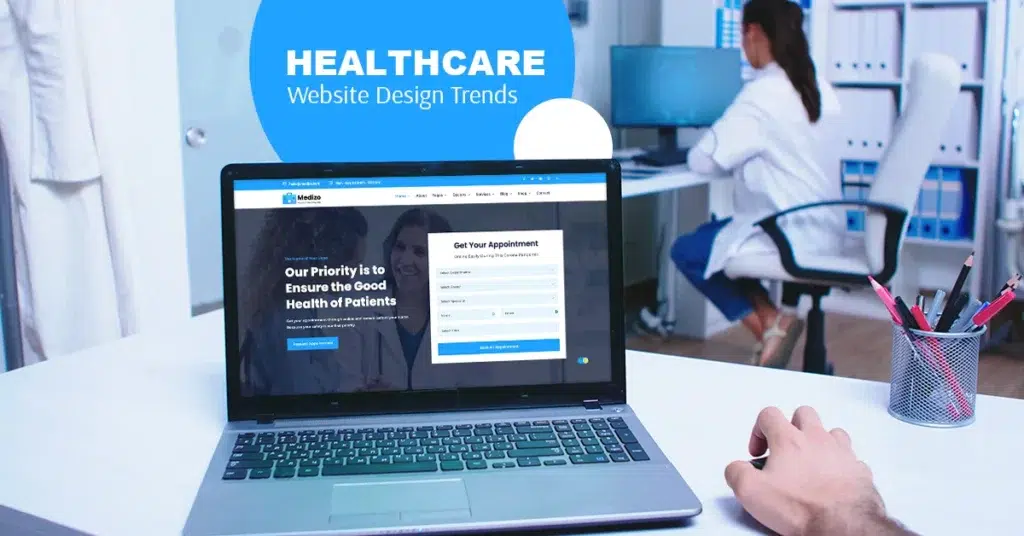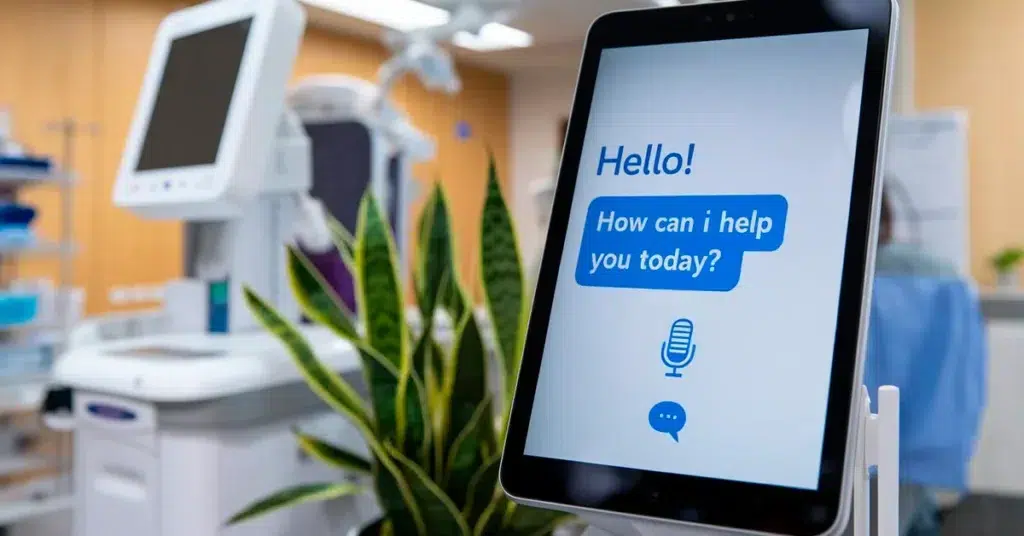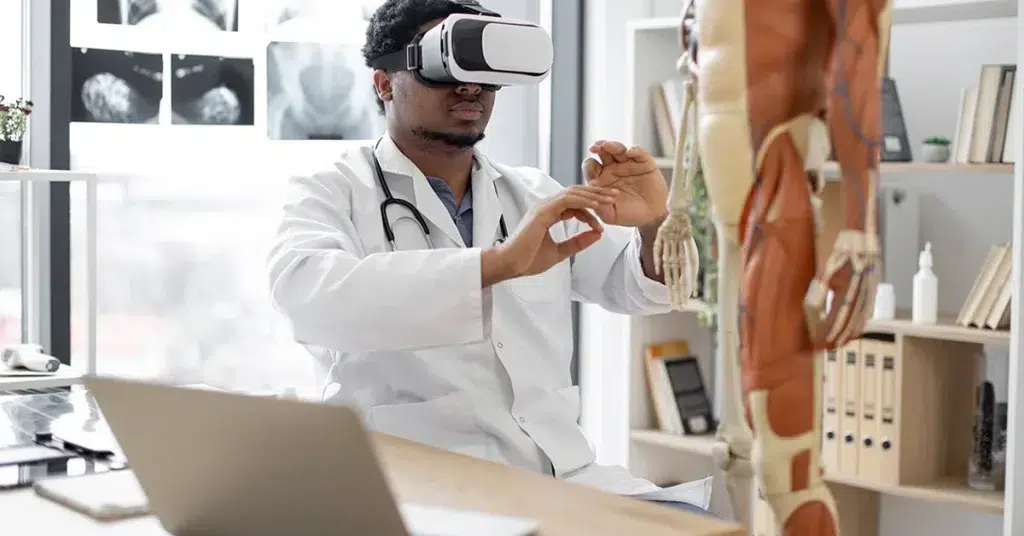
In the digital world, healthcare website design transcends mere aesthetics, focusing intently on usability and accessibility to meet the needs of diverse users. Modern medtech website design emphasizes intuitive user interfaces that enhance the patient journey, ensuring seamless navigation for everyone, including those utilizing assistive technologies.
As healthcare UX gains importance, the emphasis is on crafting platforms that are not only functional but also optimized for easy access to essential information, from patient portals to telehealth services. Using educational images and infographics to convey complex medical information allows patients to easily comprehend their medical conditions, treatment options, and expected outcomes.
With the digital healthcare landscape rapidly evolving, technologies such as remote patient monitoring and wearable devices are pivotal in improving patient outcomes. These innovations necessitate websites that support advanced integrations, enabling efficient data transfer and analysis to aid in remote care delivery.
Adhering to web content accessibility guidelines (WCAG) is crucial to ensure that healthcare websites are usable by individuals with disabilities, enhancing the overall user experience by making content perceivable, operable, understandable, and robust for users with varying needs.
Rather than adhering to traditional web approaches, contemporary healthcare websites must embrace cutting-edge design trends, ensuring a responsive and adaptable interface that mirrors the sector’s ongoing transformation. This involves optimizing for mobile use and enhancing patient interaction through digital tools, keeping healthcare web design at the forefront of revolutionizing care delivery in today’s world.
By focusing on these elements, healthcare organizations can create effective digital platforms that not only improve patient engagement but also foster trust and satisfaction, ultimately leading to better health outcomes for all patients.
User-Centric Medical Web Design Trends in Healthcare Industry

The Significance of User Experience (UX) in Healthcare
In the digital age, healthcare website design has evolved from a mere visual component to a fundamental aspect of the overall user experience. The website’s design plays a critical role in enhancing user experience by incorporating effective design elements such as clean layouts, color schemes, and intuitive navigation. As the healthcare sector grows more intricate, digital platforms must be intuitive and adaptable to meet the diverse needs of patients and medical professionals alike.
A well-designed healthcare website not only boosts patient engagement but also cultivates trust and satisfaction in healthcare services. By embracing user-centered design principles, healthcare web platforms ensure seamless interactions and streamline the digital healthcare ecosystem. These designs must be accessible to users with varying levels of digital literacy while adhering to the stringent standards of usability and functionality that the medical industry demands, ensuring healthcare organizations can deliver a seamless digital experience.
Furthermore, effective healthcare web design plays a crucial role in enhancing patient engagement, which is vital in today’s medical landscape. When websites are crafted with a focus on user needs, healthcare providers can develop interactive, dynamic platforms that facilitate improved communication and personalized care experiences.
The incorporation of digital healthcare tools, such as patient portals and telemedicine applications, further enriches patient interaction by customizing the experience to individual preferences. By concentrating on these key elements, healthcare organizations can create digital platforms that not only elevate patient engagement but also build trust and satisfaction, ultimately leading to improved health outcomes for all patients.
Boosting Patient Engagement
Effective web design is instrumental in significantly enhancing patient engagement, a vital component in today’s medical industry. The use of educational images and infographics to effectively convey complex medical information can further enhance patient engagement.
When websites are designed with users in mind, healthcare providers can create interactive, dynamic platforms that facilitate better communication. Moreover, personalised digital healthcare tools—such as patient portals and telemedicine apps—further enhance patient interaction by tailoring the experience to individual needs.
The integration of remote patient monitoring systems, alongside other Medtech innovations, elevates patient engagement by allowing real-time tracking of health metrics, thereby creating a proactive care environment. These tools enable healthcare professionals to stay connected with patients, ultimately leading to better health outcomes.
Streamlining Navigation
In healthcare, ease of navigation is not just a convenience but a necessity. Users require swift and straightforward access to critical healthcare information and services, particularly when health decisions are time-sensitive. Contemporary medical website design trends focus on crafting clear and intuitive navigation paths that guide users effortlessly, regardless of their digital literacy.
A well-structured navigation system reduces cognitive load, ensuring patients can find relevant medical information without confusion or frustration. By simplifying user interfaces and enhancing accessibility, healthcare websites can cater to diverse audiences, from elderly patients to tech-savvy younger generations, ensuring inclusivity in digital healthcare access.
Prominent Display of Essential Information
A well-designed healthcare website should prominently display essential information to facilitate easy access for patients and healthcare professionals. This includes clear and concise navigation menus, easily accessible contact information, and a visible search bar. By prioritizing the display of essential information, healthcare providers can improve the overall user experience and ensure that patients can quickly find the information they need.
In the fast-paced environment of the healthcare industry, time is of the essence. Patients often seek immediate access to critical information, such as contact details, appointment scheduling, and service descriptions. By placing this information front and center, healthcare websites can significantly enhance user satisfaction and efficiency.
Clear navigation menus help users find their way around the site effortlessly, while a visible search bar allows for quick access to specific information. Additionally, prominently displayed contact information ensures that patients can easily reach out for support or inquiries, fostering a sense of trust and reliability.
Personalisation for Healthcare Providers
Personalisation has emerged as a leading trend in medical website design. Healthcare providers now tailor content to address individual patient needs, enhancing the overall user experience. This customised approach boosts patient satisfaction by offering relevant, targeted healthcare information.
Medtech website design increasingly prioritises bespoke digital solutions, ensuring a more engaging experience for users. Consider engaging a professional bespoke medical web design company in Malaysia that able to localise contents specific to your local audience.
Tailored Engaging and Informative Content for Patients
Providing tailored content is key to enhancing user experience on healthcare platforms. By using patient reviews and delivering relevant, individualised information, healthcare professionals can foster better patient engagement. Digital health platforms, supported by electronic health records (EHR), offer personalised content recommendations, ensuring each patient receives the most pertinent information.
Customisable User Interfaces
Customisable user interfaces have become essential in healthcare web design, allowing patients to adapt their digital experiences to personal preferences. Current medical website trends highlight the importance of flexible interfaces that cater to various user needs. Remote patient monitoring systems, in particular, benefit from these adaptable designs, ensuring a more user-friendly interaction.
Mobile-First Medical Website Design for Healthcare Organizations

Rising Mobile Usage in Healthcare
The growing use of mobile devices has redefined how patients access healthcare information. With mobile-first design becoming a priority, the healthcare industry must ensure seamless experiences across all devices. Adapting to this trend is crucial for maintaining engagement and accessibility in healthcare web design.
Responsive Design Approaches
Responsive design is key to ensuring healthcare websites perform optimally across devices. By automatically adjusting layouts to suit different screen sizes, responsive healthcare website designs can enhance both usability and accessibility. Flexible grids and adaptable layouts are now central to medtech web design, ensuring smooth user experiences regardless of the device.
Mobile-Friendly Features
Mobile-friendly features are vital for improving user interaction on healthcare websites. Touch-friendly elements such as larger buttons and simplified navigation are increasingly integrated into the medical web design trends, prioritising ease of use on smaller screens. Medtech web design trends now emphasise mobile optimisation to meet the rising expectations of mobile users.
Benefits of Mobile Optimisation
Mobile optimisation brings substantial benefits to healthcare systems. By ensuring websites are optimised for mobile devices, healthcare system providers can significantly boost patient engagement. The healthcare sector gains from improved accessibility and faster load times, both crucial for delivering an efficient user experience.
Enhanced Accessibility
Mobile optimisation greatly improves accessibility, making it easier for users to obtain healthcare information on the go. By prioritising user-friendly interfaces and ensuring content is accessible to all, medtech website design caters to the diverse needs of patients. This approach ensures that healthcare web design meets accessibility standards, providing seamless access for all users.
Faster Load Times
Fast load times are essential for an optimal user experience on medical websites. Quick access to healthcare information is a priority for users, and mobile optimisation plays a key role in achieving this. Medtech design trends increasingly focus on speed and efficiency, recognising that healthcare professionals and patients alike value swift, responsive websites.
Accessibility and Inclusivity Key Elements in Healthcare Websites

Designing for All Users
Ensuring accessibility in healthcare web design is essential for creating inclusive platforms that all users can navigate without difficulty. Adhering to the Web Content Accessibility Guidelines (WCAG) ensures usability for individuals with disabilities, making content perceivable, operable, understandable, and robust.
The healthcare industry recognises the importance of adhering to accessibility standards, such as ADA compliance, which ensures that digital platforms are barrier-free for all patients. By prioritising accessible design, healthcare providers can effectively serve a wider range of users, regardless of their abilities.
ADA Compliance
ADA compliance is critical for making healthcare websites accessible to users with disabilities. Medical websites should integrate features such as screen readers and keyboard navigation, enhancing the digital experience for individuals with visual or motor impairments. By meeting these standards, healthcare providers not only comply with legal requirements but also demonstrate a commitment to inclusivity, ensuring that their medical services really are accessible to everyone.
Assistive Technologies
Incorporating assistive technologies is key to making healthcare websites more accessible. Tools like voice recognition and text-to-speech applications enable users with disabilities to interact with medical websites easily. These technologies are essential for ensuring equal access to healthcare information, allowing healthcare providers to meet the diverse needs of their patient base while improving overall user experience.
Inclusive Design Practices
Inclusive design focuses on crafting websites that accommodate a wide range of user needs. Healthcare providers must address factors such as colour contrast and readability to ensure their content is accessible to everyone. Current medtech website design trends increasingly highlight the need for inclusivity in healthcare systems, healthcare service providers ensuring that no user is left behind.
Colour Contrast and Readability
Colour contrast and readability are fundamental to inclusive web design. By selecting colour schemes that provide high contrast between text and background, healthcare professionals can significantly improve visibility for all users, particularly those with visual impairments. Prioritising these elements in medtech web design ensures a more inclusive and user-friendly experience across the board.
Alternative Text for Images
Including alternative text for images is a crucial part of accessible web design. This feature allows users relying on screen readers to access image descriptions, ensuring they can fully engage with website content. Healthcare providers must ensure every image on their platform is accompanied by alternative text, demonstrating a clear commitment to accessibility and enhancing the digital experience for users with visual impairments.
Integration of Telehealth Features in Medical Websites

Virtual Consultations
Virtual consultations are now a fundamental element of healthcare web design, enabling healthcare professionals to deliver remote care. By integrating telehealth features such as video conferencing tools, medical websites enhance patient accessibility, allowing consultations from any device. This approach not only reduces the need for travel but also makes healthcare more readily available to prospective patients, particularly for those in remote locations.
Video Conferencing Tools
Video conferencing tools facilitate seamless, real-time communication between patients and healthcare providers. Modern healthcare web design prioritises the integration of these tools to offer patients the convenience of receiving medical advice from home. For clinics, these tools reduce the operational costs associated with in-person visits, while their design focuses on clarity, usability, and an overall positive user experience.
Secure Messaging Systems
Secure messaging systems are essential for safeguarding patient data, providing a confidential channel for communication between users and healthcare professionals. The inclusion of these systems in a healthcare provider web design ensures the protection of sensitive information, while supporting the exchange of medical documents and electronic health records (EHR). By implementing secure messaging, healthcare providers foster trust and enhance patient engagement
Online Appointment Scheduling
Online appointment scheduling has transformed how patients engage with healthcare services. Modern healthcare web design now centres on developing intuitive, user-friendly booking systems that allow patients to schedule appointments at their convenience. This feature not only streamlines the patient experience but also reduces administrative workloads for clinics, ensuring a smoother operational flow.
User-Friendly Booking Interfaces
Creating simple and effective booking interfaces is essential to improving the appointment scheduling process. Current healthcare web design trends emphasise easy-to-navigate systems, enabling patients to quickly select available time slots and confirm their appointments. These interfaces also enhance efficiency for healthcare providers by minimising no-shows and simplifying appointment management.
Automated Reminders
Automated reminders play a crucial role in maintaining patient engagement and reducing missed appointments. By integrating this feature into medical websites, healthcare providers ensure patients receive timely notifications via email or text. This not only helps clinics maintain organised schedules but also enhances overall patient compliance. Seamless integration with EHR systems further boosts the efficiency of these reminders.
Patient Education and Resources
Patient education and resources are crucial components of a healthcare website. Healthcare providers should strive to create a comprehensive library of educational content, including articles, videos, and infographics, to empower patients with the knowledge they need to make informed decisions about their health. This can include information on various health conditions, treatment options, and preventive care.
A well-curated educational section not only enhances patient engagement but also positions healthcare providers as trusted sources of information. By offering a variety of content formats, such as detailed articles, engaging videos, and easy-to-understand infographics, healthcare websites can cater to different learning preferences.
This approach ensures that patients have access to reliable information that can help them understand their health better, manage conditions effectively, and take proactive steps towards preventive care. Ultimately, a robust educational resource library can lead to more informed patients and better health outcomes.
Comprehensive Health and Medical Information
Comprehensive health information is essential for patients seeking to understand their health conditions and treatment options. Healthcare providers should ensure that their website provides accurate, up-to-date, and easy-to-understand information on various health topics. This can include information on symptoms, diagnosis, treatment options, and preventive care.
In the digital age, patients often turn to the internet for health information. Therefore, it is imperative that healthcare websites offer reliable and comprehensive content. By providing detailed information on symptoms, diagnostic procedures, treatment options, and preventive measures, healthcare providers can help patients make informed decisions about their health.
This not only improves patient satisfaction but also enhances the credibility of the healthcare provider. Ensuring that the information is presented in a clear and accessible manner, free from medical jargon, further aids in patient comprehension and engagement.
Interactive Learning Tools
Interactive learning tools can enhance the patient education experience and make complex health information more engaging and accessible. Healthcare providers can incorporate interactive features such as quizzes, games, and simulations to educate patients on various health topics. These tools can also help patients track their progress and set health goals.
Interactive tools transform passive learning into an engaging experience, making it easier for patients to absorb and retain information. Quizzes can test patients’ knowledge and reinforce learning, while games and simulations can illustrate complex medical concepts in an understandable way.
Additionally, tools that allow patients to track their health progress and set goals can motivate them to take an active role in their health management. By integrating these interactive elements, healthcare websites can provide a more dynamic and effective educational experience, ultimately leading to better patient outcomes.
Use of AI and Chatbots in Healthcare Web Design

Enhancing Customer Support
AI and chatbots have transformed customer support in healthcare web design, providing immediate assistance to users. These tools allow healthcare professionals to address inquiries swiftly, improving patient satisfaction by offering efficient, round-the-clock communication. Clinics benefit from these automated systems by enhancing user engagement while reducing the workload on human staff.
24/7 Assistance
AI-powered chatbots enable healthcare websites to offer 24/7 support, ensuring users receive assistance at any time, from any location. By automating these services, medical facilities can maintain continuous interaction with patients, significantly reducing wait times and enhancing overall service availability. This digital solution promotes higher levels of patient engagement and satisfaction with medical bills.
Automated FAQs
Automated FAQ systems are an effective way to streamline information delivery on healthcare websites. AI-driven tools manage repetitive inquiries, allowing users to quickly find answers to common questions without human intervention. This not only improves user experience but also enables healthcare professionals to focus on more complex tasks, further boosting the efficiency of clinic operations.
AI-Driven Personalisation
AI-driven personalisation is revolutionising healthcare web design by offering users tailored experiences that meet their unique needs. Healthcare systems utilise AI to customise content and services, improving patient satisfaction through more personalised interactions. These digital solutions adapt seamlessly to user preferences, providing a more engaging and efficient experience.
Predictive Analytics
Predictive analytics play a pivotal role in AI-driven personalisation by enabling healthcare professionals to anticipate patient needs through data analysis. Medtech websites leverage this technology to deliver relevant content proactively, offering users more effective healthcare solutions. By incorporating data-driven insights, clinics enhance their decision-making processes, optimising patient care.
Personalised Health Recommendations
Personalised health recommendations significantly enhance the user experience on healthcare websites. AI analyses user data to provide tailored health advice, ensuring patients receive targeted tips and resources. These custom recommendations help improve patient outcomes by delivering relevant, timely health information, making digital healthcare solutions more responsive and effective.
Data Security and Privacy in Healthcare Websites

The Importance of Protecting Patient Medical Information
Ensuring data security is essential for safeguarding patient information in healthcare web design. Strict adherence to privacy standards in medtech website development is crucial for protecting sensitive data. By prioritising data security for website visitors, healthcare providers build trust with patients, reinforcing the integrity of their systems.
HIPAA Compliance
HIPAA compliance is a foundational aspect of healthcare web design. Medical websites must meet these legal standards to protect patient information from unauthorised access. By adhering to HIPAA regulations, clinics not only safeguard data but also reduce liability risks, ensuring that medical records and their operations remain secure and compliant.
Secure Data Encryption
Data encryption is vital for ensuring the confidentiality of digital information on healthcare platforms. Healthcare websites must implement strong encryption protocols to protect sensitive data, ensuring that only authorised personnel can access it. This enhances trust between patients and healthcare providers, reinforcing the commitment to security and privacy.
Building Trust with Users
Establishing trust is a cornerstone of effective healthcare web design. Transparent practices are key to fostering confidence in digital healthcare solutions, ensuring users feel secure when navigating well-constructed medical websites.
Transparent Privacy Policies
Clear and transparent privacy policies are vital in healthcare web design. Users need a thorough understanding of how their data is collected, used, and protected. By providing detailed explanations of privacy practices, healthcare professionals can build trust and reassure users that their personal information is handled with care and responsibility.
User Consent Management
Effective user consent management significantly enhances the user experience on healthcare websites. By integrating features that allow users to control their data, healthcare platforms empower patients to decide what information they are comfortable sharing. Prioritising consent management not only improves user satisfaction but also reinforces the trust between patients and healthcare systems.Visual Design Trends in Healthcare Web
Best Practices for Healthcare Web Design

Healthcare web design requires a unique approach that prioritizes user experience, accessibility, and search engine optimization (SEO). Here are some best practices for healthcare web design:
Prioritize user experience: Healthcare websites should be designed with the patient in mind, prioritizing ease of use, clear navigation, and accessible information.
Ensure accessibility: Healthcare websites should be designed to meet the needs of patients with disabilities, adhering to accessibility standards such as ADA compliance.
Optimize for search engines: Healthcare websites should be optimized for search engines to ensure maximum visibility and engagement.
Use responsive design: Healthcare websites should be designed to be responsive, catering to the increasing number of patients accessing healthcare information on their mobile devices.
Incorporate interactive features: Interactive features such as quizzes, games, and simulations can enhance the patient education experience and make complex health information more engaging and accessible.
Use high-quality images and videos: High-quality images and videos can enhance the user experience and make a healthcare website more engaging.
Prioritize data security: Healthcare websites should prioritize data security, ensuring that patient information is protected and secure.
Use clear and concise language: Healthcare websites should use clear and concise language, avoiding technical jargon and ensuring that patients can easily understand complex health information.
By following these best practices, healthcare providers can create effective healthcare websites that prioritize patient education, accessibility, and user experience. This approach not only enhances patient satisfaction but also positions healthcare providers as leaders in the digital healthcare landscape.
Minimalist Design for Healthcare Company
Minimalist design is a pivotal aspect of healthcare web design, where simplicity plays a key role in enhancing digital experiences. Healthcare professionals recognise that a clean, streamlined layout improves usability by allowing users to access information without distractions. By focusing on essential elements, medtech websites enhance both functionality and user engagement.
Clean and Simple Layouts
A clean layout ensures effortless navigation on healthcare websites. By prioritising straightforward, well-structured designs, healthcare professionals can improve user interaction and engagement. Clear, organised content reduces cognitive load, allowing users to find the information they need with ease, leading to higher satisfaction with medical websites.
Focus on Essential Elements
Focusing on essential elements is central to minimalist healthcare web design. Streamlined interfaces allow users to interact more efficiently, as only the most vital information is presented without unnecessary clutter. This focus on functionality ensures that medical websites remain highly usable, offering a more effective, distraction-free experience.
Use of Calming Colours
Calming colours play an influential role in healthcare web design, positively shaping user perception. Healthcare professionals strategically select colour schemes that promote relaxation, ensuring users feel at ease while navigating medical websites. By incorporating colour psychology, healthcare web design enhances the user experience and creates a welcoming atmosphere through thoughtful, soothing colour choices.
Colour Psychology in Healthcare
Colour psychology is a key consideration in healthcare web design, as professionals understand how colours affect emotions and behaviours. Colours that convey trust and calmness are carefully chosen to evoke positive feelings, encouraging users to engage more comfortably with medical websites. This strategic use of colour not only fosters positive interactions but also increases user engagement across all digital marketing platforms.
Creating a Welcoming Atmosphere
Establishing a welcoming atmosphere is vital in healthcare web design. A harmonious colour palette helps create an inviting digital environment where users feel comfortable exploring. By using calming, well-balanced colours, healthcare websites can set a friendly tone, enhancing the overall user experience and making the site more approachable.
Emerging Technologies
The integration of emerging technologies is shaping the future of healthcare web design. As digital platforms evolve, innovative tools like Virtual Reality (VR) and Augmented Reality (AR) are transforming the way patients and healthcare professionals interact, making medical websites more engaging and educational.
Virtual Reality (VR) Applications
Virtual Reality (VR) is revolutionising healthcare web design by providing immersive experiences that enhance user engagement. Healthcare professionals utilise VR to simulate medical procedures, allowing patients to gain a clearer understanding of treatments. By integrating VR, healthcare websites offer more interactive and informative experiences, deepening patient comprehension and involvement.
Augmented Reality (AR) in Patient Education
Augmented Reality (AR) is transforming patient education by overlaying digital content onto the real world, making complex medical concepts easier to understand. Through interactive AR features, healthcare websites offer patients dynamic learning experiences, improving health literacy. By incorporating AR, healthcare platforms elevate user engagement, providing clear, visual explanations of medical procedures and conditions.
Anticipated Changes in User Expectations
Demand for More Interactive Features
Users are increasingly seeking interactive features on healthcare websites to enhance their experience. By incorporating elements such as quizzes, simulations, and other dynamic content, healthcare professionals can engage users more effectively. Modern healthcare web design now prioritises interactive features, offering engaging digital solutions that make the healthcare business user journey more immersive and informative.
Shift Towards Preventive Care Information
Healthcare websites are shifting their focus towards preventive care, as users become more proactive about maintaining health and wellness. Patients now seek valuable guidance on healthy living, and healthcare professionals are responding by creating content that emphasises prevention. By providing tips and resources focused on mental health and wellness, healthcare web design helps users access essential information for long-term health management.
The Future of Healthcare Website Design

Today’s healthcare web design must integrate emerging medtech trends to meet evolving user expectations. Professionals need to adopt innovative strategies such as responsive design, personalised content, and telehealth integration to enhance user engagement. Data security remains a top priority in building trust, while AI-driven solutions and interactive features continue to transform digital healthcare interactions. Staying informed on these trends ensures that healthcare providers deliver optimal digital experiences, fostering a more effective and user-friendly healthcare environment.




